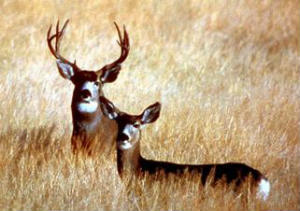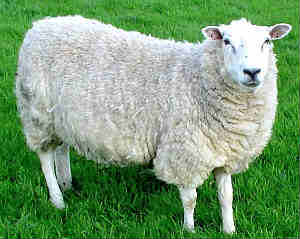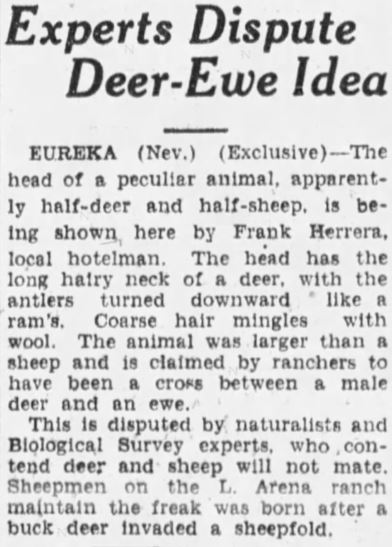Sheep/Mule Deer Hybrids
Ovis aries × Odocoileus hemionus
EUGENE M. MCCARTHY, PHD GENETICS, ΦΒΚ
A diligent scholar is like a bee who takes honey from many different flowers and stores it in his hive.
—John Amos Comenius
|
An article about a mule deer/sheep hybrid appeared in the issue of The Ogden Standard (Apr. 1, 1918, p. 7, col. 4), a newspaper published in Ogden City, Utah. (Note that the April first date of the story should raise eyebrows!)
SHEEP GIVES BIRTH TO LAMBS
FATHERED BY DEER

Mule Deer

Domestic Sheep
Chromosome counts:
Ovis aries: 2n=54
O. hemionus: 2n=70
In a letter received this morning at the local headquarters of the forest service from Supervisor W. W. Blakeslee of the Toiyabe Forest near Austin, Nevada, there is a report of a freak of nature concerning the crossing of wild and tame animals of the same general species.
The report states the crossing of sheep and wild deer has become an established fact. It discloses that seven ewes recently gave birth to lambs that showed plainly the deer cross. A the forest office it was said by an attache when the report was first circulated its correctness was seriously doubted.
Investigation, however, proved that the thing actually happened. The herder, who was with the sheep, stated that a buck deer ran with the band for a period of six days in Wall Canyon. Of the number to which the ewes gave birth, three have died, but the remaining four are strong, vigorous and doing well.
The freaks have the deer marks and characteristics. They jump like deer with their long, light legs. Their hair is not woolly, nor does it greatly resemble that of a deer. Their ears, however, are straight up like those of a deer and not like those of a sheep. Great interest will be attached to these animals as they grow older.
Another article about a deer-sheep appeared in the Tonopah Daily Bonanza (Nov. 11, 1920, p. 4, col. 2), a newspaper in Tonopah, Nevada:
DEER-SHEEP WANTS MATE
The strange animal at the Arena ranch, half deer, half sheep, is now two years old, and has begun showing the traits of his ancestors on both sides, says the Reese River Reveille. He has the horns of a sheep, the head and hair of a deer, and his body and legs are very much like both. In fighting he uses the tactics of a ram, backing up and charging, and in a row with one of the rams has broken one of his horns. This is the mating season for deer, and recently he has developed traits peculiar to the wild side of his breeding. He is cross and full of fight, and wants the freedom of the hills and to associate with his kind, and it has been found necessary to hobble him to keep him from jumping the fence and taking to the wilds. Last week in spite of the hobbles, he cleared the high corral fence and went to the mountains in search of a mate. Joe Gilbert, the Indian chief, found him high up the mountain and brought him to town, and wen the Reveille's naturalist interviewed him, he seemed very much peeved at having his vacation interrupted. He resented being tied up, and didn't seem to enjoy familiarity from strangers. He was returned to the ranch and hobbled fore and aft, and it is expected this will prevent his jumping the high fence again until his restless fit passes.
The following is an excerpt from a article that appeared on page 2 of the July 23, 1910, issue of the Goodwin's Weekly, a newspaper published in Salt Lake City, Utah (source):
The writer spent a night at Egon Canyon Nev., some forty years ago, the guest of Col. Daugherty, who was running some mines there. He had brought a little band of sheep with him and during the evening was telling how the sheep had mated with the wild black-tail deer in the neighborhood [black-tailed deer are usually treated as a subspecies of O. hemionus], and that the lambs were half sheep and half deer. Next morning, going outside the house, a band of sheep were seen perhaps 75 yards away. Daugherty was asked if those were his indiscreet sheep. He laughed and called loudly: “Billy, come here!” Whereupon one separated from the others, and came bounding up to Daugherty. “Billie” was a perfect deer in form, action, and especially in his glorious eyes, but he had a patch of wool on his back as big as an English jockey saddle.
News report:
A white-tailed deer/sheep hybrid is pictured and briefly described in the Richmond, Virginia
Times (
Jun. 1, 1902, p. 2):
There are also at least tree brief mentions of hybrids between sheep and white-tailed deer (O. virginianus), a type of deer belonging to the same genus as O. hemionus; they can be accessed here, here and here. Another notice about a hybrid between a sheep and what may be presumed, from the locale of the publication, to have been a white-tailed deer can be read here.
The news report, which appeared in the Los Angeles Times (Nov. 10, 1927, p. 9, col. 2; ||y49t8lkm), probably would have involved a mule deer sire given the locale:
A Red Deer/Sheep Hybrid
In addition, a sheep × red deer (Cervus elaphus) hybrid is described in the following excerpt from a paper read at the New York Farmers' Club by sheep expert L. A. Morell. It appeared on page 4 of the Green-Mountain Freeman (Nov. 19, 1873, p. 4), a newspaper published in Montpelier, Vermont.
In closing, I will mention another
curiosity, and to me a perfect anomaly, viz., a hybrid being a cross of the common red deer and sheep. Both belong, it is true, to the order
ruminantia, but it is the first and only instance that has ever come to my knowledge. … This hybrid is covered with straight hair, in color, reddish-brown, legs rather long, and uncouth in general outline. The herdsman informed me that it was found and purchased by a gentleman now living in New York, when traveling in Europe, and presented to the Park Commissioners. This great curiosity…may be seen any day herding with a small and beautiful flock of full-bred Southdowns.
More about sheep-deer hybrids >>
Table of contents >>
Bibliography >>
Internet citations >>
Biology Dictionary >>
By the same author: Handbook of Avian Hybrids of the World, Oxford University Press (2006).
 Mule Deer
Mule Deer Domestic Sheep
Domestic Sheep